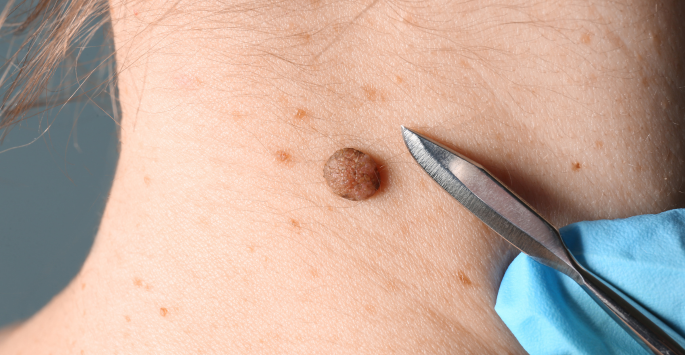
We all know the main purpose of a skin cancer screening is to screen for… you guessed it… skin cancer. But sometimes, skin cancer doesn’t make itself very obvious, and it can hide behind other seemingly benign issues. Here are certain things your dermatologist knows to look for that you might have misdiagnosed yourself.
Skin cancer is a serious health concern that affects millions of people worldwide. While many people are aware of the most common places for skin cancer to develop, such as the face, arms, and legs, there are some uncommon places and conditions that people may not consider when it comes to detecting and preventing skin cancer.
Black Finger Nails
Unless you’ve recently caused trauma to your fingertip by accidentally squashing or hitting it, that black fingernail should be cause for immediate concern. Many people don’t realize that a melanoma (the deadliest form of skin cancer) can actually appear beneath your fingernail. We’re not saying every black fingernail is melanoma, but if it appears out of nowhere we consider it worthwhile to check it out. It can appear on the whole nail, a small blotch, or a straight line.
Persistent Pimples
Before you get nervous about every single pimple you get and start overanalyzing every blemish as potential skin cancer, there’s a little more to this. If you have a pimple that hasn’t responded to any skincare products or medications and it’s been months, you should be going to a dermatologist to have it looked at anyway. But in some cases, basal cell carcinomas can evade the common signs such as the ABCs of skin cancer and just look like a plain old zit. If it’s not going away, it’s time to have it examined.
Chapped Lips
If it’s the middle of winter, the air is dry, and you notice your normally soft lips feel dry and cracked, you’re probably fine just slathering on some moisturizing balm and waiting for your lips to heal. But if this is a chronic issue that keeps coming back again and again (especially in the same spot), you might have actinic cheilitis, also known as a pre-cancerous lesion on your lips. Since the skin on your lips is consistently exposed to UV light it makes sense that they would be susceptible to damage over time. And it's most common on your bottom lip. It’s worth speaking to a dermatologist if you have chronically chapped lips, whether you suspect it’s skin cancer or not, because it’s an uncomfortable condition that you shouldn’t have to suffer with long term anyway. And with the right treatment, you may finally get rid of it.
Random, Painless Lumps
If you noticed a pink, purple, or reddish bump that’s appeared on your skin and it doesn’t hurt, you’d probably ignore it. And most of the time, you may be right in assuming it’s some sort of blister or blemish. But there’s an incredibly rare form of skin cancer called Merkel cell carcinoma that looks exactly like this (although it's possible they are also metastatic melanomas or even metastatic breast cancer depending on the location). Sometimes they’re as small as a mole or as large as a quarter, and it's worth nothing that while they usually aren't painful, they sometimes might be when they're new. so if you have a weakened immune system and you’re exposed to the sun just give yourself the peace of mind by seeing your dermatologist and having it checked.
Scaly Scalp
One uncommon place where skin cancer can develop is on the scalp. People with thinning hair or who shave their heads may be more susceptible to skin cancer on their scalp. This is because the scalp is often exposed to the sun without any protection, making it an easy target for harmful UV rays. To prevent skin cancer on the scalp, it's important to wear a hat or use a scalp sunscreen when spending time in the sun.
Palms & Soles
It seems odd that you could develop skin cancer in an area that rarely sees the light of day as directly as your head, chest, and shoulders. But it does, and it can be difficult to spot because of how thick the skin is here. If you spend a lot of time outdoors, keep on gloves and shoes, and if you’re at the beach or pool and exposing the soles of your feet keep them covered in sunscreen or flip flops. Make a point of checking your palms and soles once a month and make note of any new spots (even small ones) and changes in pigment.
